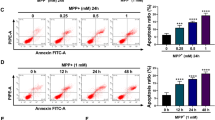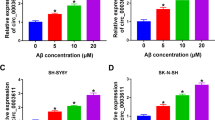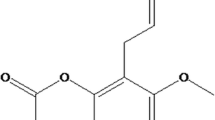Abstract
Dexmedetomidine (Dex) is reported to play a neuroprotective role in Alzheimer’s disease (AD). However, the specific mechanism remains unclear. Figure out the underlying molecular mechanism of Dex regulating nerve cell apoptosis in the AD model. The AD model in vitro was established after SH-SY5Y cells were treated with Aβ1 − 42 at (10 μM) for 24 h. The interaction among UPF1, lncRNA SNHG14, and HSPB8 was verified by RIP assay. Cell viability, apoptosis, the level of genes, and proteins were detected by CCK-8 assay, flow cytometry, Western blot, and qRT-PCR, respectively. Dex downregulated lncRNA SNHG14 level and inhibited apoptosis of nerve cells. LncRNA SNHG14 overexpression reversed the inhibitory effect of Dex on nerve cell apoptosis in the AD model. LncRNA SNHG14 attenuated HSPB8 mRNA stability by recruiting UPF1. HSPB8 overexpression inhibited apoptosis of nerve cells in the AD model. Moreover, HSPB8 knockdown reversed the inhibitory effect of Dex on nerve cell apoptosis in the AD model. Our study demonstrated that Dex promoted HSPB8 expression via inhibiting the lncRNA SNHG14/UPF1 axis to inhibit nerve cell apoptosis in AD.





Similar content being viewed by others
Data Availability
The raw data supporting the conclusions of this manuscript will be made available by the authors, without undue reservation, to any qualified researcher.
References
Banesh S, Trivedi V (2021) CD36 ectodomain detects apoptosis in mammalian cells. Mol Biotechnol 63(11):992–1003
Chen Y, Peng C, Chen J, Chen D, Yang B, He B et al (2019) WTAP facilitates progression of hepatocellular carcinoma via m6A-HuR-dependent epigenetic silencing of ETS1. Mol Cancer 18(1):127
Ding XD, Cao YY, Li L, Zhao GY (2021) Dexmedetomidine reduces the lidocaine-induced neurotoxicity by inhibiting inflammasome activation and reducing pyroptosis in rats. Biol Pharm Bull 44(7):902–909
Dong H, Wang W, Chen R, Zhang Y, Zou K, Ye M et al (2018) Exosome-mediated transfer of lncRNA-SNHG14 promotes trastuzumab chemoresistance in breast cancer. Int J Oncol 53(3):1013–1026
Dong H, Wang W, Mo S, Liu Q, Chen X, Chen R et al (2018) Long non-coding RNA SNHG14 induces trastuzumab resistance of breast cancer via regulating PABPC1 expression through H3K27 acetylation. J Cell Mol Med 22(10):4935–4947
Duan R, Wang SY, Wei B, Deng Y, Fu XX, Gong PY et al (2021) Angiotensin-(1–7) analogue AVE0991 modulates astrocyte-mediated neuroinflammation via lncRNA SNHG14/miR-223-3p/NLRP3 pathway and offers neuroprotection in a transgenic mouse model of Alzheimer’s disease. J Inflamm Res 14:7007–7019
Faghihi MA, Modarresi F, Khalil AM, Wood DE, Sahagan BG, Morgan TE et al (2008) Expression of a noncoding RNA is elevated in Alzheimer’s disease and drives rapid feed-forward regulation of beta-secretase. Nat Med 14(7):723–730
Fotuhi SN, Khalaj-Kondori M, HoseinpourFeizi MA, Talebi M (2019) Long non-coding RNA BACE1-AS may serve as an Alzheimer’s disease blood-based biomarker. J Mol Neurosci MN 69(3):351–359
Han S, Cao D, Sha J, Zhu X, Chen D (2020) LncRNA ZFPM2-AS1 promotes lung adenocarcinoma progression by interacting with UPF1 to destabilize ZFPM2. Mol Oncol 14(5):1074–1088
He Y, Qiang Y (2021) Mechanism of autonomic exercise improving cognitive function of Alzheimer’s disease by regulating lncRNA SNHG14. Am J Alzheimers Dis Other Demen 36:15333175211027680
Hong H, Mo Y, Li D, Xu Z, Liao Y, Yin P et al (2020) Aberrant expression profiles of lncRNAs and their associated nearby coding genes in the hippocampus of the SAMP8 mouse model with AD. Molec Ther Nucleic acids 20:140–54
Hu G, Shi Z, Shao W, Xu B (2022) MicroRNA-214-5p involves in the protection effect of dexmedetomidine against neurological injury in Alzheimer’s disease via targeting the suppressor of zest 12. Brain Res Bull 178:164–172
Huaying C, Xing J, Luya J, Linhui N, Di S, Xianjun D (2020) A signature of five long non-coding RNAs for predicting the prognosis of Alzheimer’s disease based on competing endogenous RNA networks. Front Aging Neurosci 12:598606
Jiang H, Ni J, Zheng Y, Xu Y (2021) Knockdown of lncRNA SNHG14 alleviates LPS-induced inflammation and apoptosis of PC12 cells by regulating miR-181b-5p. Exp Ther Med 21(5):497
Lashley T, Schott JM, Weston P, Murray CE, Wellington H, Keshavan A et al (2018) Molecular biomarkers of Alzheimer’s disease: progress and prospects. Dis Mod Mech 11(5)
Li D, Zhang J, Li X, Chen Y, Yu F, Liu Q (2021) Insights into lncRNAs in Alzheimer’s disease mechanisms. RNA Biol 18(7):1037–1047
Li H, Zhang X, Chen M, Chen J, Gao T, Yao S (2018) Dexmedetomidine inhibits inflammation in microglia cells under stimulation of LPS and ATP by c-Fos/NLRP3/caspase-1 cascades. EXCLI J 17:302–311
Li Z, Ho IHT, Li X, Xu D, Wu WKK, Chan MTV et al (2019) Long non-coding RNAs in the spinal cord injury: novel spotlight. J Cell Mol Med 23(8):4883–4890
Lou CH, Shao A, Shum EY, Espinoza JL, Huang L, Karam R et al (2014) Posttranscriptional control of the stem cell and neurogenic programs by the nonsense-mediated RNA decay pathway. Cell Rep 6(4):748–764
Lu J, Liu X, Zheng J, Song J, Liu Y, Ruan X et al (2020) Lin28A promotes IRF6-regulated aerobic glycolysis in glioma cells by stabilizing SNHG14. Cell Death Dis 11(6):447
Pei CL, Fei KL, Yuan XY, Gong XJ (2019) LncRNA DANCR aggravates the progression of ovarian cancer by downregulating UPF1. Eur Rev Med Pharmacol Sci 23(24):10657–10663
Qin H, Ni H, Liu Y, Yuan Y, Xi T, Li X et al (2020) RNA-binding proteins in tumor progression. J Hematol Oncol 13(1):90
Ren Q, Zhao S, Ren C, Ma Z (2018) Astragalus polysaccharide alleviates LPS-induced inflammation injury by regulating miR-127 in H9c2 cardiomyoblasts. Int J Immunopathol Pharmacol 32:2058738418759180
Riva P, Ratti A, Venturin M (2016) The long non-coding RNAs in neurodegenerative diseases: novel mechanisms of pathogenesis. Curr Alzheimer Res 13(11):1219–1231
Rusmini P, Cortese K, Crippa V, Cristofani R, Cicardi ME, Ferrari V et al (2019) Trehalose induces autophagy via lysosomal-mediated TFEB activation in models of motoneuron degeneration. Autophagy 15(4):631–651
Sun W, Zhao J, Li C (2020) Dexmedetomidine provides protection against hippocampal neuron apoptosis and cognitive impairment in mice with Alzheimer’s disease by mediating the miR-129/YAP1/JAG1 axis. Mol Neurobiol 57(12):5044–5055
Sun YB, Zhao H, Mu DL, Zhang W, Cui J, Wu L et al (2019) Dexmedetomidine inhibits astrocyte pyroptosis and subsequently protects the brain in in vitro and in vivo models of sepsis. Cell Death Dis 10(3):167
Ta Na HS, An M, Zhang T, Deni W, Hou L, Jin K (2022) Dexmedetomidine inhibits microglial activation through SNHG14/HMGB1 pathway in spinal cord ischemia-reperfusion injury mice. Int J Neurosci 132(1):77–88
Vendredy L, Adriaenssens E, Timmerman V (2020) Small heat shock proteins in neurodegenerative diseases. Cell Stress Chaperones 25(4):679–699
Vicario M, Skaper SD, Negro A (2014) The small heat shock protein HspB8: role in nervous system physiology and pathology. CNS Neurol Disord: Drug Targets 13(5):885–895
Wang K, Wu M, Xu J, Wu C, Zhang B, Wang G et al (2019) Effects of dexmedetomidine on perioperative stress, inflammation, and immune function: systematic review and meta-analysis. Br J Anaesth 123(6):777–794
Wang X, Lai Q, He J, Li Q, Ding J, Lan Z et al (2019) LncRNA SNHG6 promotes proliferation, invasion and migration in colorectal cancer cells by activating TGF-β/Smad signaling pathway via targeting UPF1 and inducing EMT via regulation of ZEB1. Int J Med Sci 16(1):51–59
Wang X, Yu X, Wei W, Liu Y (2020) Long noncoding RNA MACC1-AS1 promotes the stemness of nonsmall cell lung cancer cells through promoting UPF1-mediated destabilization of LATS1/2. Environ Toxicol 35(9):998–1006
Wilhelmus MM, Boelens WC, Otte-Höller I, Kamps B, Kusters B, Maat-Schieman ML et al (2006) Small heat shock protein HspB8: its distribution in Alzheimer’s disease brains and its inhibition of amyloid-beta protein aggregation and cerebrovascular amyloid-beta toxicity. Acta Neuropathol 111(2):139–149
Xie X, Lin J, Liu J, Huang M, Zhong Y, Liang B et al (2019) A novel lncRNA NR4A1AS up-regulates orphan nuclear receptor NR4A1 expression by blocking UPF1-mediated mRNA destabilization in colorectal cancer. Clin Sci (London, England : 1979) 133(13):1457–73
Xue F, Zhang W, Chu HC (2016) Assessing perioperative dexmedetomidine reduces the incidence and severity of acute kidney injury following valvular heart surgery. Kidney Int 89(5):1164
Yuan J, Wu Y, Li L, Liu C (2020) MicroRNA-425–5p promotes tau phosphorylation and cell apoptosis in Alzheimer’s disease by targeting heat shock protein B8. J Neural Transm (Vienna, Austria : 1996) 127(3):339–46
Zaepfel BL, Zhang Z, Maulding K, Coyne AN, Cheng W, Hayes LR et al (2021) UPF1 reduces C9orf72 HRE-induced neurotoxicity in the absence of nonsense-mediated decay dysfunction. Cell Rep 34(13):108925
Zhang LM, Wang MH, Yang HC, Tian T, Sun GF, Ji YF et al (2019) Dopaminergic neuron injury in Parkinson’s disease is mitigated by interfering lncRNA SNHG14 expression to regulate the miR-133b/ α-synuclein pathway. Aging 11(21):9264–9279
Zhong Y, Yu C, Qin W (2019) LncRNA SNHG14 promotes inflammatory response induced by cerebral ischemia/reperfusion injury through regulating miR-136-5p /ROCK1. Cancer Gene Ther 26(7–8):234–247
Acknowledgements
We would like to give our sincere gratitude to the reviewers for their constructive comments.
Funding
This work was supported by the Scientific Research Project of Heilongjiang Health Commission to Yu Sun (20210404110036) and the Basic Scientific Research Funding Project for colleges and universities of Heilongjiang Province to QingDong Wang (2023-KYYWF-0636).
Author information
Authors and Affiliations
Contributions
QingYun Tan, LiLi Liu, QingDong Wang, and Yu Sun wrote the main manuscript text and QingYun Tan, LiLi Liu, and Shuo Wang prepared figures. All authors reviewed the manuscript.
Corresponding authors
Ethics declarations
Ethics Statement
Not applicable. This article does not contain any studies with human participants or animals performed by any of the authors.
Consent for Publication
Not applicable.
Conflict of Interest
There are no conflicts of interest to declare.
Additional information
Publisher's Note
Springer Nature remains neutral with regard to jurisdictional claims in published maps and institutional affiliations.
QingYun Tan and LiLi Liu They are the co-first authors.
Supplementary Information
Below is the link to the electronic supplementary material.
Rights and permissions
Springer Nature or its licensor (e.g. a society or other partner) holds exclusive rights to this article under a publishing agreement with the author(s) or other rightsholder(s); author self-archiving of the accepted manuscript version of this article is solely governed by the terms of such publishing agreement and applicable law.
About this article
Cite this article
Tan, Q., Liu, L., Wang, S. et al. Dexmedetomidine Promoted HSPB8 Expression via Inhibiting the lncRNA SNHG14/UPF1 Axis to Inhibit Apoptosis of Nerve Cells in AD. Neurotox Res 41, 471–480 (2023). https://doi.org/10.1007/s12640-023-00653-4
Received:
Revised:
Accepted:
Published:
Issue Date:
DOI: https://doi.org/10.1007/s12640-023-00653-4




